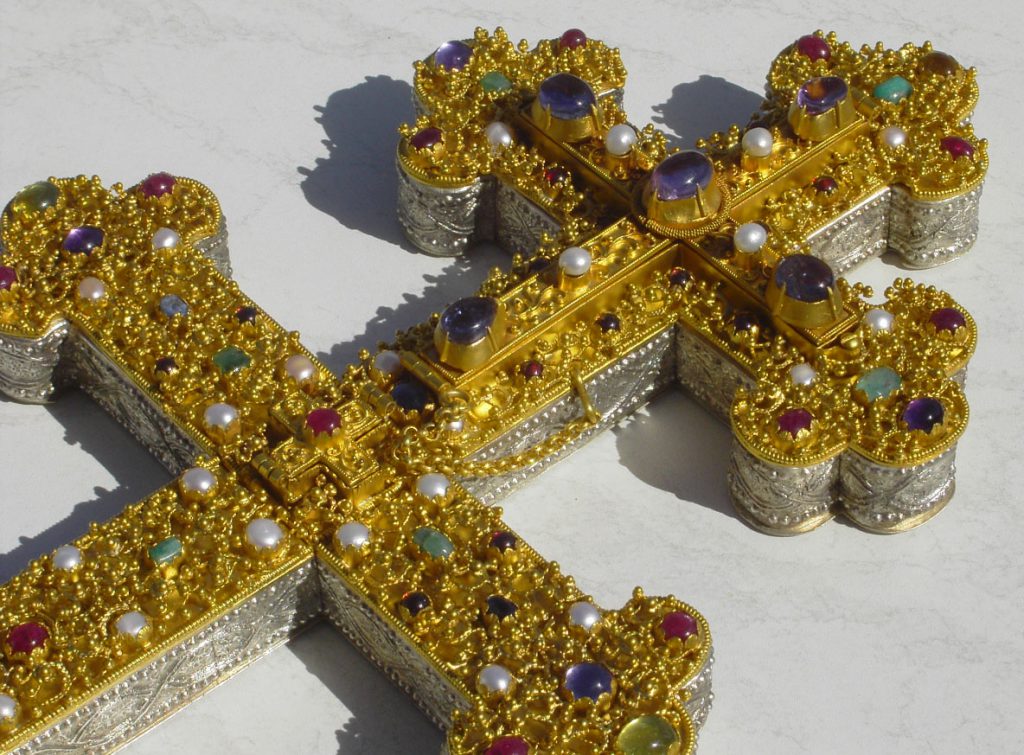For me, one of the most beautiful and elaborate altar crosses is the so-called “Abbess cross” from the abbey treasury Abbey of St. John in Aachen Burtscheid.
The cross has been traced back to the 12th century and is one of the most prominent exhibits at this lesser-known Abbey Treasury Museum.
When I first visited the museum in Aachen-Burtscheid, it was love at first sight. 😉 It was immediately clear to me that I wanted to try to make a replica of this artistically remarkable altar cross in the form of a Byzantine double cross.
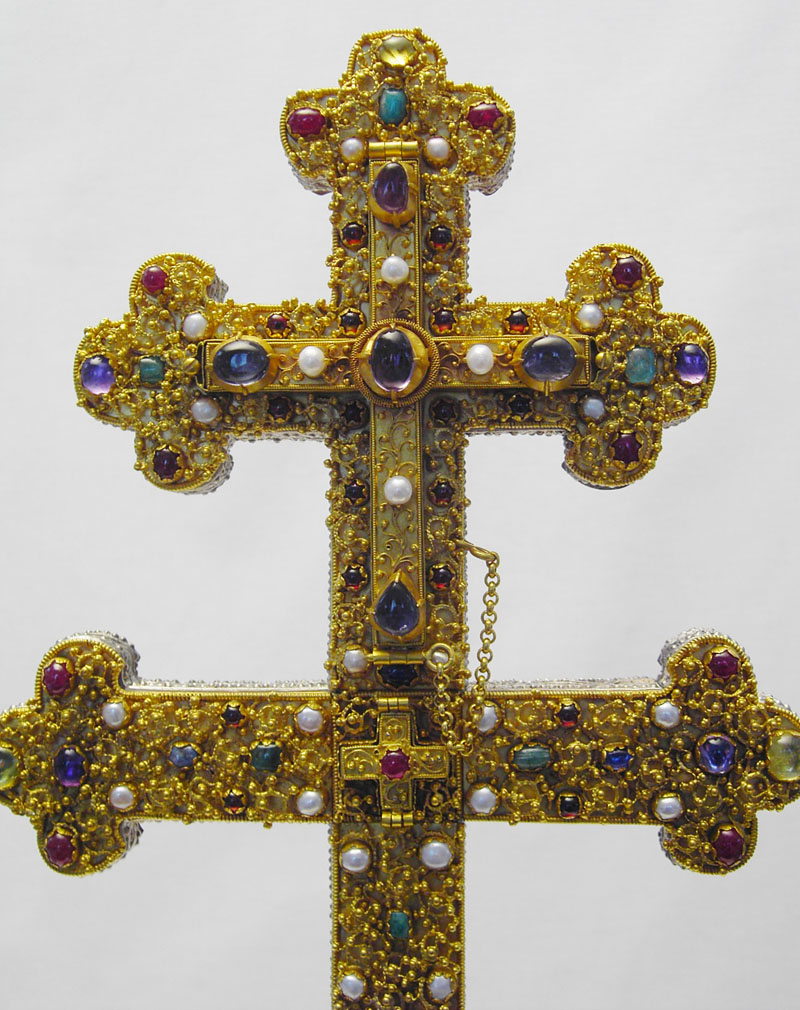
The rare, three-dimensional filigree, the rich trimmings with gemstones and pearls, the cross compartment that can be opened twice to hold a relic and the very elaborate engraving on the back made me want to test the limits of my craftsmanship on this object.
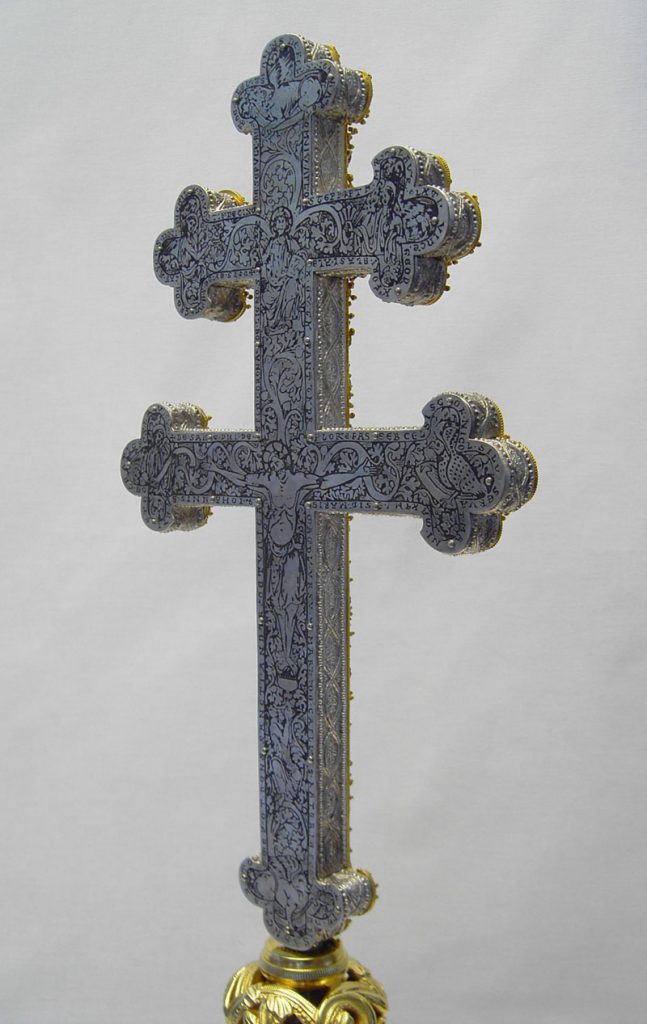
In almost 1500 hours of work, a replica of the abbess cross that was almost true to the original was finally created.
The front fittings with the gemstone and pearl settings and the elaborate, 3-dimensional filigree were gilded with 24 carat fine gold. The real highlight, however, is the almost true-to-original and particularly high-quality gemstone trimming:
32 genuine cultured pearls, 1 hand-cut rock crystal, 15 blood-red rubies, 7 Colombian emeralds, 4 sapphires, 3 beryls, 7 amethysts, 3 iolites and 18 almandines ignite a veritable firework display.
The larger cross placed on top (in the original it contains a cross relic) can be opened using a cotter pin attached to a small chain, the small cross in the middle is firmly closed.
The elaborately decorated side panels were each individually hand-cast, fitted manually and then silver-plated. The true-to-original replica of the engraving on the back (see below for details on the representation) was etched into the copper, then electroplated with silver and patinated by hand. Inside the cross there is a solid wooden core, analogous to the original.
The base, which deviates from the original but is stylistically appropriate, is an excellent Wilhelminian copy of a Romanesque candlestick. It was also extensively reworked:
It is hand-polished, galvanically sealed and then gilded with 24 carat fine gold. The base was patinated very little in order to emphasize the character of the originality of this former processional cross again and to emphasize it appropriately.
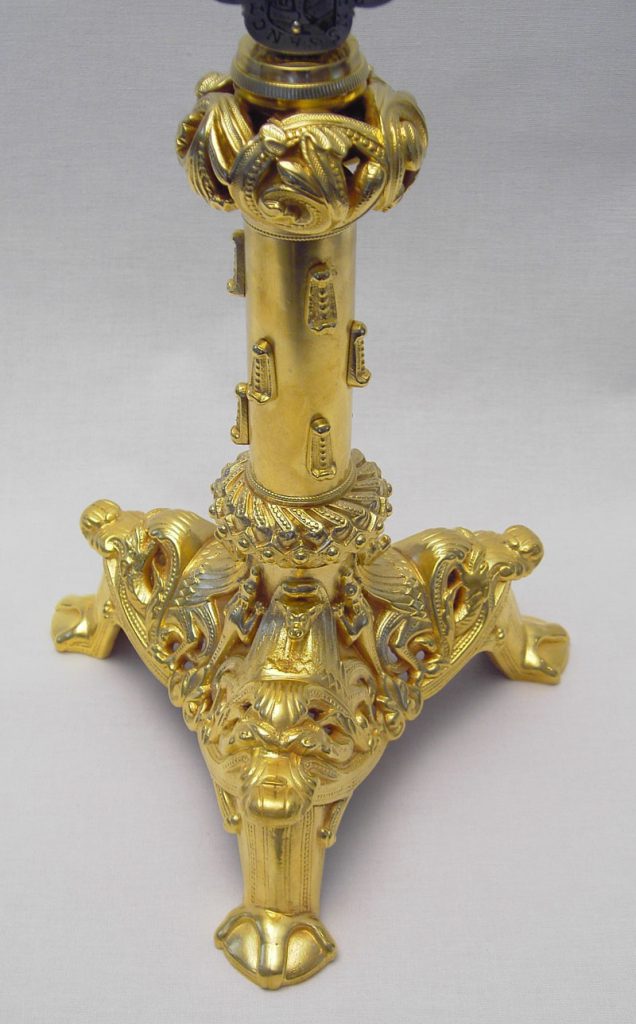
When making the cross, a conscious attempt was made to capture something of the incomparable flair and special aura of the antique original from the High Middle Ages, ie the pure gold plating as well as the silver-plated sides and the engraving on the back were patinated all around - i.e. artificially aged, there were intentional dents and other minor signs of wear were added and the quality of the gemstone and pearl settings as well as the filigree was largely based on the condition of the original.
I am still very satisfied with the result today. This is the reward for making as few technical compromises as possible when implementing the individual details and thus trying to get the end result as close as possible to the historical original.
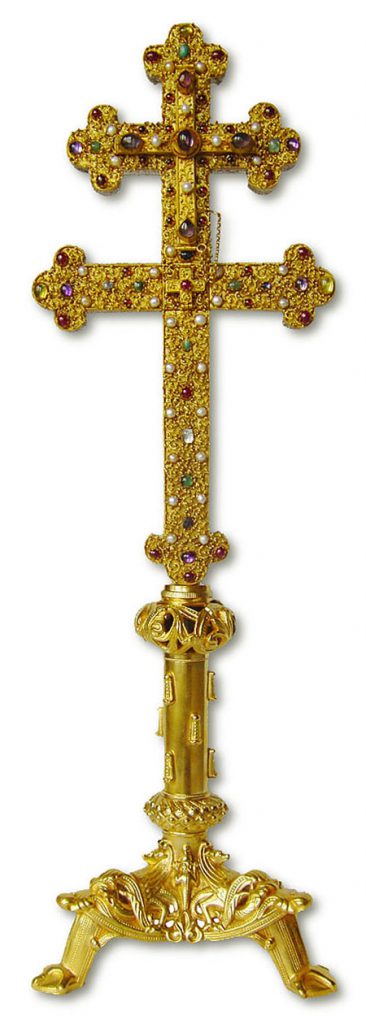
Art-historical details on the Burtscheid original:
Hardly had Helswindis von Gimmenich, the first Cistercian superior, taken over the abbess staff (1222) when a reliquary cross can be found in the Burtscheid treasury, which is one of the finest that has come down to us from Rhine-Maasland art from the late flowering period in the high Middle Ages. It measures 34,3 cm and consists of a wooden core covered with gilded silver sheet. Rich filigree work, 35 precious stones, sapphires, rubies, amethysts and smoky topazes and 32 pearls adorn the front, the back is covered with a plate decorated entirely in niello technique. Around 1860, the goldsmith Dautzenberg added the missing parts for 180 marks at the expense of a Miss von Loevenich from Krefeld. In 1866 the cross was mounted on a wooden base.
Again, the form of the double cross (so-called Crux bipartita) refers to an exemplary Byzantine type, which was widespread on the Rhine and Meuse at that time. A Byzantine cross reliquary from the turn of the millennium, which fell to Philip II during the loot of the Constantinople crusade, may have played a particularly important role in the veneration of cross reliquaries in the Rhine-Maasland. Philipp donated it to the Maastricht Church of Our Lady. In an adventurous manner, it ended up in the treasury of St. Peter in Rome at the beginning of the 19th century. The Burtscheid cross shows related proportions, and the ornamentation of its stamped sheet metal seems like a template for the filigree that the Maasland workshops loved so much. The Burtscheid cross is part of a series of major works by Hugo von Oignies and the exposure of his art in Namur, Brussels, Walcourt and the Clairmarais cross of the Cathedral of St. Omer.
The ends of the beams flow into trefoils. The actual reliquary chamber of the upper crossing is closed by a flat, largely restored cross with filigree, stones in raised crab settings and pearls. The lower cross decoration shows a similarly designed smaller cross. Strongly twining ring filigree surrounds staggered gemstones and the accompanying lower set pearls. Punched strips with a leaf pattern in floral braided bands cover the side edges. The dense ringed filigree has its closest equivalent in the Aachen shrine to Mary, which was completed in 1238 and has comparable decorative elements, primarily on the front side with the enthroned Christ, but also on the long side with the enthroned Mary. These are the parts of the younger Marian shrine workshop, so that it can already be concluded that the Burtscheid cross was made after 1230.
If the front already impresses with the well-balanced proportions of its elements and the disciplined, masterfully organized splendor of its canon of decoration, the nielloed picture side places the cross in the unique series of masterpieces of this technique. Rarely has the technically difficult art of the niello achieved such a sovereign, even "classic" effect as on the Burtscheid Cross. Through the rampant tendrils, which proliferate over the surfaces in a constantly changing repeat, the cross becomes the tree of life, combined with the idea of Christ as the true vine, in whose branches the mysteries of Christ's act of redemption are embedded. The dominating center is occupied by the Crucified, whose death is transformed into redemption through the donation of his life-giving blood. Beneath his feet in the fence branches is Ecclesia, holding a chalice into which flow the streams of blood from the Lord's foot wounds.
The Tree of Life of the Cross continues to rise with luxuriant branches unfurling as if by chance into a trefoil shape, before which Christ is enthroned as the Glorified One. He raised his right hand in blessing, his left hand holding the book of the Gospels. Angels bearing lilies appear in the lateral trefoils. They face Christ in profile to offer the crown and three nails of the cross to Rex gloria as symbols of kingship and human nature.
The symbols of the four evangelists, who surround the cross as the center of the earth, appear in the other end tridents as key witnesses to the entire mystical vision. But the pictorial canon also corresponds to a proclamation of the word. It surrounds the tree of life as a framing inscription and names the relic particles for the sake of which the cross was primarily created and whose sanctifying power the cross owes its transfiguring beauty to:
“De san(guine) D(omi)ni, de spin(ea) corona, de ligno s(crucis), de p(rae)sep(e), de sepulcro, de lap(ide) asc(ensioni)s D (omi)ni. de capillo, de vestib(us), de cin(ul)o, de sepuic(ro) be(atae) v(irginis) M(ariae), de reliquiis be(atae) Anne. de re(liquiis) be(at)i Jo(hannis) ba(p)tistae) et omnium ap(osto)lo(rum, Stehph(ani) p(ro)tom(a)r(tyris), Laur(entii ), Sixti Vince(ntii), Geor(gii), C(hrist)ofori, Blasiffl, Alex(ii), Eu(sta)thii, Pant(aleonis), Th(eo)d(o)r(i), Flore(ntii), Fab(iani), Seb(astiani), Celsi(i), S(an)c(ti), Co(n)f(essoris) Nicol(ai), Silv(ii), Servat(ii ), Ma(r)t(i)ni, Maxim(in)i, Egid(ii), Marie Magd(a)I(enae), Ursu(lae), Marg(aretae), de Capill(is), S Cather(ina)e, Scol(asticae), de (cruce) Pe(tri), dens S. Bartolemei et dens Si. Andr(eae), de tunica S. Johannis Baptistae, de cratic(ula) S(an) c(ti) Laurentii.”
The Christ type points to the change in the idea of Christ, as it occurs at the time of the emergence of the cross from the triumphant, crowned Christ to the suffering, self-sacrificing Redeemer. The monumental rood screen crucifixes in Wechselburg and Halberstadt are the stylistic examples that have been preserved for this new conception of Christ, of which our crucifix also bears witness. The limbs pierced by four nails are replaced by three nails, in which a single nail binds both feet together in a cruel metaphor of suffering. The Corpus Christi already shows a certain degree of muscular form above the moving perocinium, indicating that we are on the threshold of the Byzantine formality to a revival of ancient pictorial forms initiated by Nicholas of Verdun.
However, how strongly the Middle Byzantine version of Christ “crucified” on the Arbor vitae remains supporting the depiction on the Burtscheid Cross is shown by an example that has unfortunately only survived in a painting on a tabernacle door (Vienna, Kunsthistorisches Museum). It was created around 1438 and attributed to Jacopo Bellini (around 1400 - before 1471). Although this authorship is very doubtful, in any case we are dealing with a painter whose realistic depiction is unusual for this time. He describes the Greek Bishop Bessarion, who came to the Council of Ferrara-Florence in 1438 and stayed in the country after its dissolution. He bequeathed his valuable manuscripts to the city of Venice. He gave the brothers of the Scuola della Carita a reliquary richly adorned with later images, in the center of which the golden Crux bipartita appears. Closely related in outline to the “Maastricht” cross, the crucifix bears the greatest resemblance to the Burtscheid corpus.
The fact that the cross belongs to the Burtscheid Treasury is also documented as an old abbey property because it is mentioned in old treasury registers. A memorial in the Düsseldorf State Archives from the beginning of the 18th century says: "A Creutz set with pearls and precious stones together with a new foot decorated with stone and silver from anno 1701."
The question remains how this cross was used. Was it mainly a processional cross, as a last-century thread used to screw onto a staff would have you believe? Everything speaks against the making of a processional cross for the most precious treasure of relics guarded in the monastery. To clarify the question, a relief that belongs to the pictorial decoration of the so-called arm reliquary of Charlemagne can be used. It was probably created shortly after Charlemagne's canonization in 1165 and was a predecessor to the Charlemagne shrine commissioned at the time. Beatrice, the wife of Emperor Friedrich Barbarossa, appears in the right of the five arcades dividing the front long side. “Manibus velatis” with veiled hands she holds the Byzantine double cross in her right. In this relief, which was probably created 70 years earlier, one is tempted to swap the empress for the abbess for a moment - one would have an exact image of the function that the Burtscheid Cross served.
It was probably the insignia of the abbess of Burtscheid in the treasure of its wealth of relics, the beauty of its jewels and pictures. It is certainly no coincidence that the cross was made at a time when the Cistercians had taken over the Burtscheid Abbey. Her most urgent task must have been to create an emblem for her abbey, which the abbess wore “manibus velatis” on the most solemn occasions, like the empress on the reliquary of Charlemagne. The origin of these crosses of blessing can be traced back to Eusebius of Caesarea (died around 340), who describes the triumph of Constantine the Great on October 29.10.312, 547: “And since he was aware of the divine help, he immediately ordered that the statue the token of our Lord's passion, the cross, is given into my hand." This motif lights up pictorially in the mosaics of San Vitale in Ravenna (around XNUMX). They show the Emperor Justinian and his wife Theodora with their entourage. They carry the golden paten and the chalice as a kind of presentation of the imperial offerings in the church. Archbishop Maximinianus, who holds the Crux gemmata in his right hand, also belongs to this imperial pictorial creation of the “Oblatio Augusti et Augustae”. Like him, the abbess also carried the holy cross into the church in Burtscheid as an ever-renewing offering.

